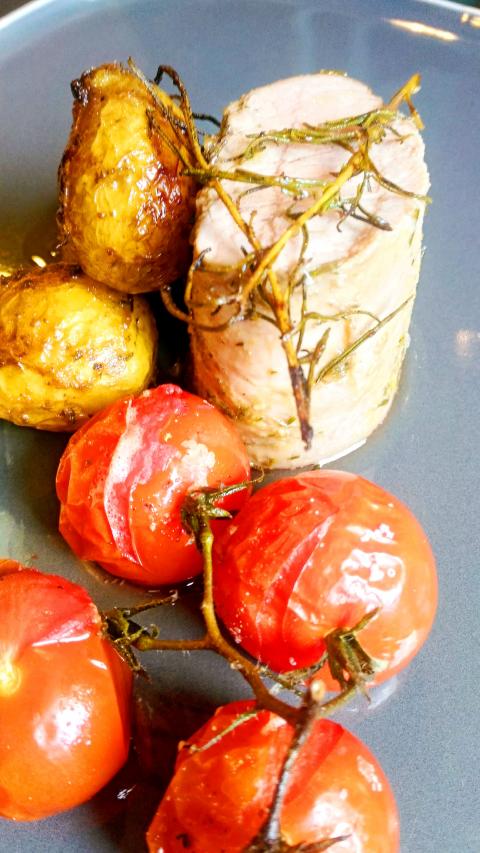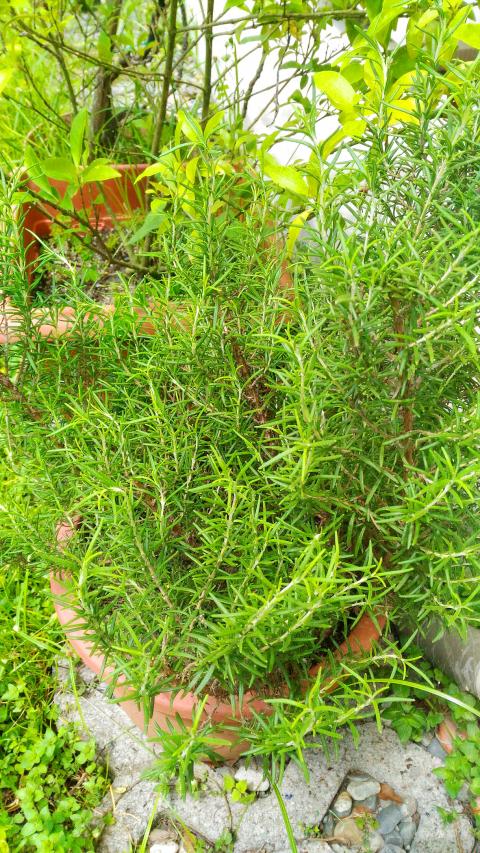Its versatility in the kitchen is amazing, but what is even more remarkable about rosemary is how easy it is to grow and maintain. No green thumbs required! It has the added advantage of thriving in containers, so a tub on the balcony or even a pot on the kitchen window is all that is necessary. In Taiwan, the only danger, apart from complete neglect, is from damp, and just ensuring that it gets sufficient sunshine and enough water is all that is required. It’s a perennial, so you don’t ever have to worry about running out. Most importantly, when you grow your own, you can access this powerhouse of flavor and aroma at any time, and never have to worry about stale, bland dried rosemary that has been sitting in the spice drawer for far too long. It is always fresh, full of character and a pretty decorative feature either indoors in a pot or outdoors as part of a more ambitious herb garden.
Even with the recent wet weather, rosemary has a way of evoking dry, fragrant landscapes, perhaps the hills of Provence in summer or some other Mediterranean idyll. It can be incorporated into all kinds of dishes, everything from grilled meats and fried fish to sweets (its perfectly delicious with apple tart or if you are feeling especially adventurous, paired with a dark chocolate brownie). Rosemary can also be infused with oil to good effect for use both in the kitchen and around the house, or brewed with other herbs into a delicious and vitalizing tea.
The scientific name for rosemary is rosmarinus officinalis, with “rosmarinus” deriving from the Latin words “ros” meaning “dew” and “marinus” for ocean. In mythology, the derivation has been said to come from “Rose of Mary,” associated with a story of the Virgin Mary turning the white flowers of a bed of rosemary blue after resting upon it. In more recent history, rosemary is associated with the tragedy of the Gallipoli landings by Australian and New Zealand troops in World War One, as it grows wild on the peninsula and is now often worn as part of the ANZAC day commemoration. Rosemary, with its clean, refreshing smell, was also considered sacred by many early cultures and, on a more mundane level, is helpful with pest control in the garden.

Photo: Ian Bartholomew
There are many cultivars of rosemary, with upright and trailing versions, with spiky leaves, fat soft leaves or yellow streaked leaves; it also flowers very prettily, with blue, pink or white flowers. Most can be used interchangeably in the kitchen. One medium sized pot from the gardening shop can be made to go a long way with a bit of careful husbanding. Rosemary can easily be grown from cuttings, so if you have a plant of rosemary that you particularly like, take some cuttings and turn your single plant into a whole garden of rosemary in just a couple of months.
Rosemary is usually used in relatively small quantities so in terms of nutritional value, it does not provide much value, but it does contain a wide variety of phytochemicals which have been used extensively in various traditional medicinal remedies. At its most basic, inhaling rosemary oil is said to relieve headache and help alleviate depression, and even if it doesn’t, it is quite a pleasant thing to do, especially if paired with a nice fruity olive oil. Some even say that the smell of rosemary helps to improve memory, and Shakespeare has given this idea greater currency with the phrase “rosemary, that is for remembrance,” spoken by Ophelia in the play Hamlet. Science does back this up to some extent, with studies showing memory improvement supposedly induced by the scent of rosemary, but despite my own great fondness for this herb I have not noticed any improvement for myself in this area. High doses of rosemary, quantities that most people would not be expected to ingest in a single sitting, can have detrimental effects on health, even inducing coma or causing miscarriage, but this is at the fringes of normality, and any normal, or even copiously generous, addition to food is not likely to be harmful.
Rosemary and balsamic roasted pork tenderloin

Photo: Ian Bartholomew
Recipe(serves four)
This is a roast that takes next to no time to put together but has a nicely sophisticated feel so that it can hold its own as a special meal despite its ease of preparation. Good quality tenderloin that has been carefully trimmed of loose meat and any lingering membrane makes for the best eating, soft and tender under the knife, and the use of ample quantities of fresh rosemary gives an intense fragrance and strong herbal notes to the meat.
Ingredients
2 x pork tenderloin, trimmed
12 baby potatoes, well scrubbed
2 zucchini, cut into large chunks
12 cherry tomatoes
6 sprigs of rosemary
4 cloves garlic
2 tsp aged balsamic vinegar
2 tsp extra-virgin olive oil
Sea salt and black pepper for seasoning
Directions
1. Trim the loose bits of meat off the tenderloin to create a neat roll. The bits of extra meat can be sliced up with a sharp knife and put aside for quick Chinese-style stir-fries.
2. Bring a pot of water to a boil and steam the baby potatoes over high heat for 15 minutes.
3. In a food processor or using a mortar and pestle, mash together the garlic, rosemary leaves, balsamic vinegar, olive oil and salt and pepper into a thick paste. Rub it over the tenderloin.
4. Place the zucchini and cherry tomatoes in another baking tray and drizzle with olive oil, seasoning generously with salt and pepper.
5. In an oven pre-heated to 200c, place a metal baking tray with a little oil and heat it for 5 minutes. Remove and place the meat into the hot tray.
6. Quickly toss the hot steamed potatoes in what remains of the herb and oil mixture and add to the baking tray.
7. Place the two trays, one with meat and potatoes, the other with the zucchini and tomato on an upper shelf of the oven for 10 minutes.
8. Remove the meat tray from the oven and turn the tenderloin over. Cook for another 6-8 minutes or until internal temperature reaches 60c at its thickest point. Remove both trays.
9. Allow the meat to rest for at least 10 minutes before cutting into four sections.
Ian Bartholomew runs Ian’s Table, a small guesthouse in Hualien. He has lived in Taiwan for many years writing about the food scene and has decided that until you look at farming, you know nothing about the food you eat. He can be contacted at Hualien202@gmail.com.

May 11 to May 18 The original Taichung Railway Station was long thought to have been completely razed. Opening on May 15, 1905, the one-story wooden structure soon outgrew its purpose and was replaced in 1917 by a grandiose, Western-style station. During construction on the third-generation station in 2017, workers discovered the service pit for the original station’s locomotive depot. A year later, a small wooden building on site was determined by historians to be the first stationmaster’s office, built around 1908. With these findings, the Taichung Railway Station Cultural Park now boasts that it has

The latest Formosa poll released at the end of last month shows confidence in President William Lai (賴清德) plunged 8.1 percent, while satisfaction with the Lai administration fared worse with a drop of 8.5 percent. Those lacking confidence in Lai jumped by 6 percent and dissatisfaction in his administration spiked up 6.7 percent. Confidence in Lai is still strong at 48.6 percent, compared to 43 percent lacking confidence — but this is his worst result overall since he took office. For the first time, dissatisfaction with his administration surpassed satisfaction, 47.3 to 47.1 percent. Though statistically a tie, for most

Wooden houses wedged between concrete, crumbling brick facades with roofs gaping to the sky, and tiled art deco buildings down narrow alleyways: Taichung Central District’s (中區) aging architecture reveals both the allure and reality of the old downtown. From Indigenous settlement to capital under Qing Dynasty rule through to Japanese colonization, Taichung’s Central District holds a long and layered history. The bygone beauty of its streets once earned it the nickname “Little Kyoto.” Since the late eighties, however, the shifting of economic and government centers westward signaled a gradual decline in the area’s evolving fortunes. With the regeneration of the once

In February of this year the Taipei Times reported on the visit of Lienchiang County Commissioner Wang Chung-ming (王忠銘) of the Chinese Nationalist Party (KMT) and a delegation to a lantern festival in Fuzhou’s Mawei District in Fujian Province. “Today, Mawei and Matsu jointly marked the lantern festival,” Wang was quoted as saying, adding that both sides “being of one people,” is a cause for joy. Wang was passing around a common claim of officials of the People’s Republic of China (PRC) and the PRC’s allies and supporters in Taiwan — KMT and the Taiwan People’s Party — and elsewhere: Taiwan and